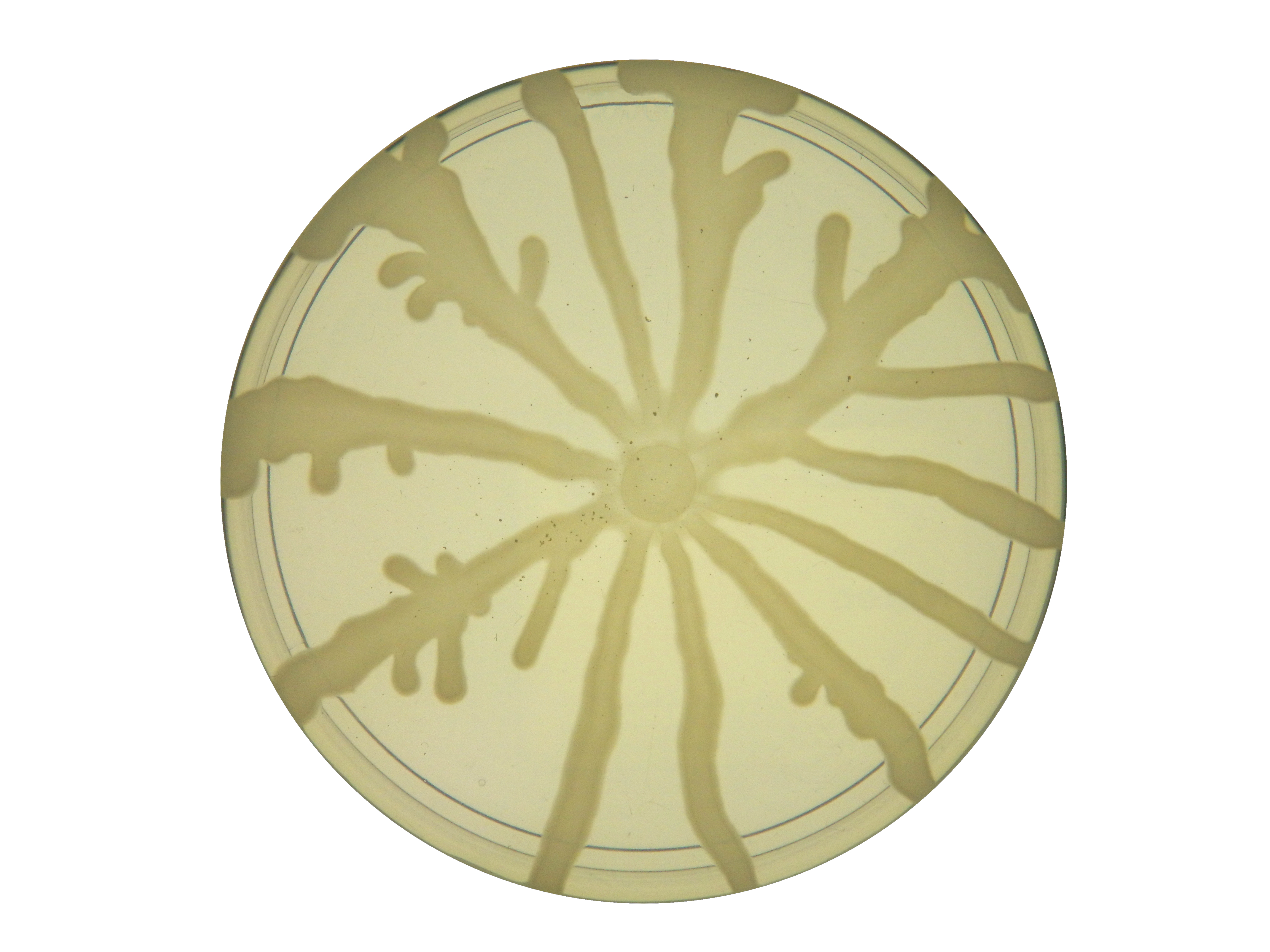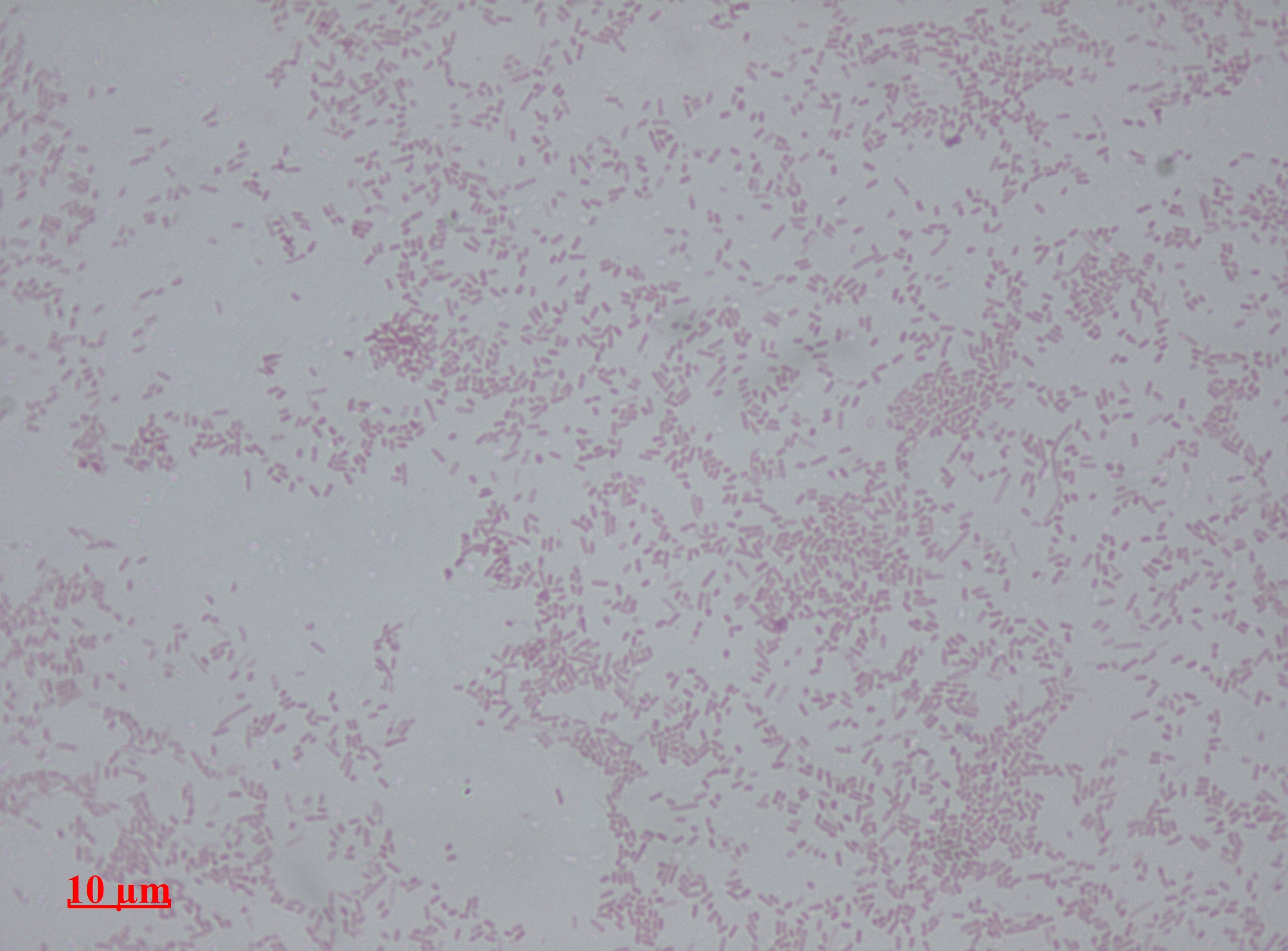|
Swarming Motility
Swarming motility is a rapid (2–10 μm/s) and coordinated translocation of a bacterial population across solid or semi-solid surfaces, and is an example of bacterial multicellularity and swarm behaviour. Swarming motility was first reported by Jorgen Henrichsen and has been mostly studied in genus ''Serratia'', ''Salmonella'', ''Aeromonas'', ''Bacillus'', ''Yersinia'', ''Pseudomonas'', ''Proteus (bacterium), Proteus'', ''Vibrio'' and ''Escherichia''. This multicellular behavior has been mostly observed in controlled laboratory conditions and relies on two critical elements: 1) the nutrient composition and 2) viscosity of culture medium (i.e. % agar). One particular feature of this type of motility is the formation of dendritic fractal-like patterns formed by migrating swarms moving away from an initial location. Although the majority of species can produce tendrils when swarming, some species like ''Proteus mirabilis'' do form concentric circles motif instead of dendritic patter ... [...More Info...] [...Related Items...] OR: [Wikipedia] [Google] [Baidu] |
Proteus (bacterium)
''Proteus'' is a genus of Gram-negative bacteria. It is a rod shaped, aerobic and motile bacteria, which is able to migrate across surfaces due its “swarming” characteristic in temperatures between 20 and 37 °C. Their size generally ranges from 0.4 to 0.8 μm in diameter and 1.0–3.0 μm in length. They tend to have an ammonia smell. ''Proteus'' bacilli are widely distributed in nature as saprophytes, being found in decomposing animal matter, sewage, manure soil, the mammalian intestine, and human and animal feces. They are opportunistic pathogens, commonly responsible for urinary and septic infections, often nosocomial. The term Proteus signifies changeability of form, as personified in the Homeric poems in Proteus, "the old man of the sea", who tends the sealflocks of Poseidon and has the gift of endless transformation. The first use of the term “Proteus” in bacteriological nomenclature was made by Hauser (1885), who described under this term three types of o ... [...More Info...] [...Related Items...] OR: [Wikipedia] [Google] [Baidu] |
Salmonella Typhimurium
''Salmonella enterica'' subsp. ''enterica'' is a subspecies of ''Salmonella enterica'', the rod-shaped, flagellated, aerobic, Gram-negative bacterium. Many of the pathogenic serovars of the ''S. enterica'' species are in this subspecies, including that responsible for typhoid. Serovars ''Salmonella enterica'' subsp. ''enterica'' serovars are defined based on their somatic (O) and flagellar (H) antigens, with over 2,600 serovars in total; only about 50 of these serovars are common causes of infections in humans. Most of these serovars are found in the environment and survive in plants, water, and soil; many serovars have broad host ranges that allow them to colonize different species in mammals, birds, reptiles, amphibians, and insects. Zoonotic diseases, like ''Salmonella'', spread between the environment and people. A number of techniques are currently used to differentiate between serotypes. These include looking for the presence or absence of antigens, phage typing, molecul ... [...More Info...] [...Related Items...] OR: [Wikipedia] [Google] [Baidu] |
Quorum Sensing
In biology, quorum sensing or quorum signaling (QS) is the process of cell-to-cell communication that allows bacteria to detect and respond to cell population density by gene regulation, typically as a means of acclimating to environmental disadvantages. Quorum sensing is a type of cellular signaling, and can be more specifically considered a type of paracrine signaling. However, it also contains traits of autocrine signaling: a cell produces both an autoinducer molecule and the receptor for the autoinducer. As one example, quorum sensing enables bacteria to restrict the expression of specific genes to the high cell densities at which the resulting phenotypes will be most beneficial, especially for phenotypes that would be ineffective at low cell densities and therefore too energetically costly to express. Many species of bacteria use quorum sensing to coordinate gene expression according to the density of their local population. In a similar fashion, some social insects use q ... [...More Info...] [...Related Items...] OR: [Wikipedia] [Google] [Baidu] |
Biosurfactant
Biosurfactant usually refers to surfactants of microbial origin. Most of the biosurfactants produced by microbes are synthesized extracellularly and many microbes are known to produce biosurfactants in large relative quantities. Some are of commercial interest. As a secondary metabolite of microorganisms, biosurfactants can be processed by the cultivation of biosurfactant producing microorganisms in the stationary phase on many sorts of low-priced substrates like biochar, plant oils, carbohydrates, wastes, etc. High-level production of biosurfactants can be controlled by regulation of environmental factors and growth circumstances. Classification Biosurfactants are usually categorized by their molecular structure. Like synthetic surfactants, they are composed of a hydrophilic moiety made up of amino acids, peptides, (poly)saccharides, or sugar alcohols and a hydrophobic moiety consisting of fatty acids. Correspondingly, the significant classes of biosurfactants include glycolipi ... [...More Info...] [...Related Items...] OR: [Wikipedia] [Google] [Baidu] |
Proteus Mirabilis
''Proteus mirabilis'' is a Gram-negative, facultatively Anaerobic organism, anaerobic, rod-shaped bacterium. It shows swarming motility and urease activity. ''P. mirabilis'' causes 90% of all ''Proteus (bacterium), Proteus'' infections in humans. It is widely distributed in soil and water. ''Proteus mirabilis'' can migrate across the surface of solid media or devices using a type of cooperative group motility called swarming. ''Proteus mirabilis'' is most frequently associated with Urinary tract infection, infections of the urinary tract, especially in complicated or catheter-associated urinary tract infections. Diagnosis An alkaline urine sample is a possible sign of ''P. mirabilis''. It can be diagnosed in the lab due to characteristic swarming motility, and inability to metabolize lactose (on a MacConkey agar plate, for example). Also ''P. mirabilis'' produces a very distinct fishy odor. Disease This rod-shaped bacterium has the ability to produce high levels of urease, whi ... [...More Info...] [...Related Items...] OR: [Wikipedia] [Google] [Baidu] |
Escherichia
''Escherichia'' ( ) is a genus of Gram-negative, non-Endospore, spore-forming, Facultative anaerobic organism, facultatively anaerobic, rod-shaped bacteria from the family Enterobacteriaceae. In those species which are inhabitants of the gastrointestinal tracts of warm-blooded animals, ''Escherichia'' species provide a portion of the microbially derived vitamin K for their host. A number of the species of ''Escherichia'' are pathogenic. The genus is named after Theodor Escherich, the discoverer of ''Escherichia coli''. ''Escherichia'' are facultative aerobes, with both aerobic and anaerobic growth, and an optimum temperature of 37 °C. ''Escherichia'' are usually motile by Flagellum, flagella, produce gas from fermentable carbohydrates, and do not decarboxylate lysine or hydrolyze arginine. Species include ''Escherichia albertii, E. albertii'', ''Escherichia fergusonii, E. fergusonii'', ''Escherichia hermannii, E. hermannii'', ''Escherichia ruysiae, E. ruysiae'', ''Escherichia ... [...More Info...] [...Related Items...] OR: [Wikipedia] [Google] [Baidu] |
Vibrio
''Vibrio'' is a genus of Gram-negative bacteria, which have a characteristic curved-rod (comma) shape, several species of which can cause foodborne infection or soft-tissue infection called Vibriosis. Infection is commonly associated with eating undercooked seafood. Being highly salt tolerant and unable to survive in freshwater, ''Vibrio'' spp. are commonly found in various salt water environments. ''Vibrio'' spp. are facultative anaerobes that test positive for oxidase and do not form spores. All members of the genus are motile. They are able to have polar or lateral flagellum with or without sheaths. ''Vibrio'' species typically possess two chromosomes, which is unusual for bacteria. Each chromosome has a distinct and independent origin of replication, and are conserved together over time in the genus. Recent phylogenies have been constructed based on a suite of genes (multilocus sequence analysis). O. F. Müller (1773, 1786) described eight species of the genus ''Vibrio ... [...More Info...] [...Related Items...] OR: [Wikipedia] [Google] [Baidu] |
Pseudomonas
''Pseudomonas'' is a genus of Gram-negative bacteria belonging to the family Pseudomonadaceae in the class Gammaproteobacteria. The 348 members of the genus demonstrate a great deal of metabolic diversity and consequently are able to colonize a wide range of niches and hosts. Their ease of culture ''in vitro'' and availability of an increasing number of ''Pseudomonas'' strain genome sequences has made the genus an excellent focus for scientific research; the best studied species include '' P. aeruginosa'' in its role as an opportunistic human pathogen, the plant pathogen '' P. syringae'', the soil bacterium '' P. putida'', and the plant growth-promoting '' P. fluorescens, P. lini, P. migulae'', and '' P. graminis''. Because of their widespread occurrence in water and plant seeds such as dicots, the pseudomonads were observed early in the history of microbiology. The generic name ''Pseudomonas'' created for these organisms was defined in rather vague terms by Walter Migula i ... [...More Info...] [...Related Items...] OR: [Wikipedia] [Google] [Baidu] |
Bacillus Subtilis Swarm
''Bacillus'', from Latin "bacillus", meaning "little staff, wand", is a genus of Gram-positive, rod-shaped bacteria, a member of the phylum ''Bacillota'', with 266 named species. The term is also used to describe the shape (rod) of other so-shaped bacteria; and the plural ''Bacilli'' is the name of the class of bacteria to which this genus belongs. ''Bacillus'' species can be either obligate aerobes which are dependent on oxygen, or facultative anaerobes which can survive in the absence of oxygen. Cultured ''Bacillus'' species test positive for the enzyme catalase if oxygen has been used or is present. ''Bacillus'' can reduce themselves to oval endospores and can remain in this dormant state for years. The endospore of one species from Morocco is reported to have survived being heated to 420 °C. Endospore formation is usually triggered by a lack of nutrients: the bacterium divides within its cell wall, and one side then engulfs the other. They are not true spores (i.e., ... [...More Info...] [...Related Items...] OR: [Wikipedia] [Google] [Baidu] |
Yersinia
''Yersinia'' is a genus of bacteria in the family Yersiniaceae. ''Yersinia'' species are Gram-negative, coccobacilli bacteria, a few micrometers long and fractions of a micrometer in diameter, and are facultative anaerobes. Some members of ''Yersinia'' are pathogenic in humans; in particular, '' Y. pestis'' is the causative agent of the plague. Rodents are the natural reservoirs of ''Yersinia''; less frequently, other mammals serve as the host. Infection may occur either through blood (in the case of ''Y. pestis'') or in an alimentary fashion, occasionally via consumption of food products (especially vegetables, milk-derived products, and meat) contaminated with infected urine or feces. Speculations exist as to whether or not certain ''Yersinia'' can also be spread by protozoonotic mechanisms, since ''Yersinia'' species are known to be facultative intracellular parasites; currently, there are studies and discussions of the possibility of amoeba-vectored (through the cyst ... [...More Info...] [...Related Items...] OR: [Wikipedia] [Google] [Baidu] |
Bacillus
''Bacillus'', from Latin "bacillus", meaning "little staff, wand", is a genus of Gram-positive, rod-shaped bacteria, a member of the phylum ''Bacillota'', with 266 named species. The term is also used to describe the shape (rod) of other so-shaped bacteria; and the plural ''Bacilli'' is the name of the class of bacteria to which this genus belongs. ''Bacillus'' species can be either obligate aerobes which are dependent on oxygen, or facultative anaerobes which can survive in the absence of oxygen. Cultured ''Bacillus'' species test positive for the enzyme catalase if oxygen has been used or is present. ''Bacillus'' can reduce themselves to oval endospores and can remain in this dormant state for years. The endospore of one species from Morocco is reported to have survived being heated to 420 °C. Endospore formation is usually triggered by a lack of nutrients: the bacterium divides within its cell wall, and one side then engulfs the other. They are not true spores (i.e. ... [...More Info...] [...Related Items...] OR: [Wikipedia] [Google] [Baidu] |




